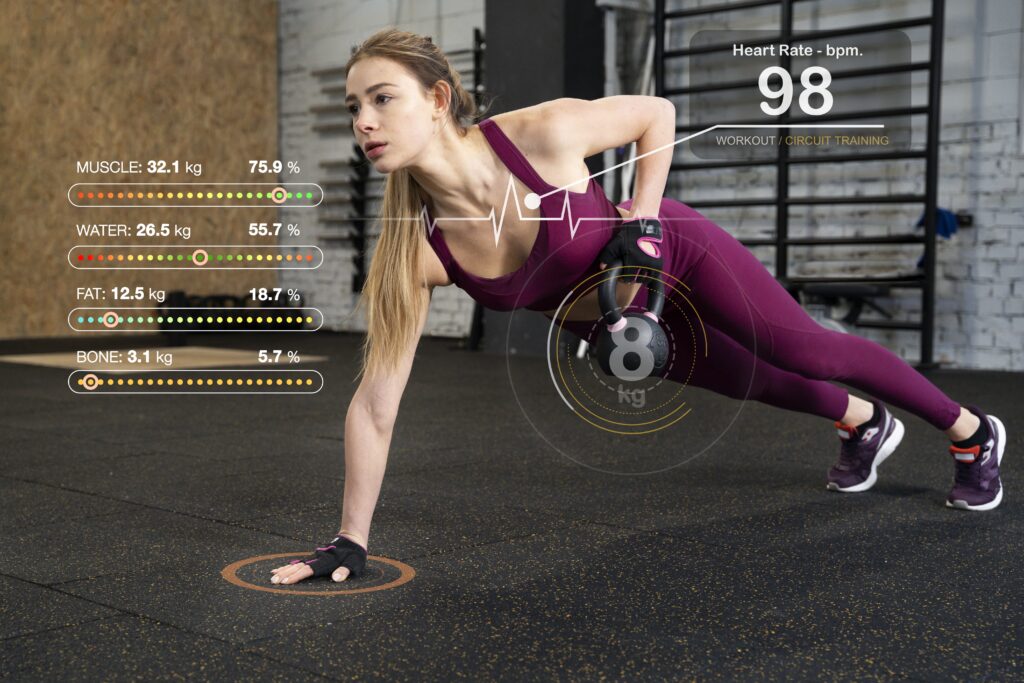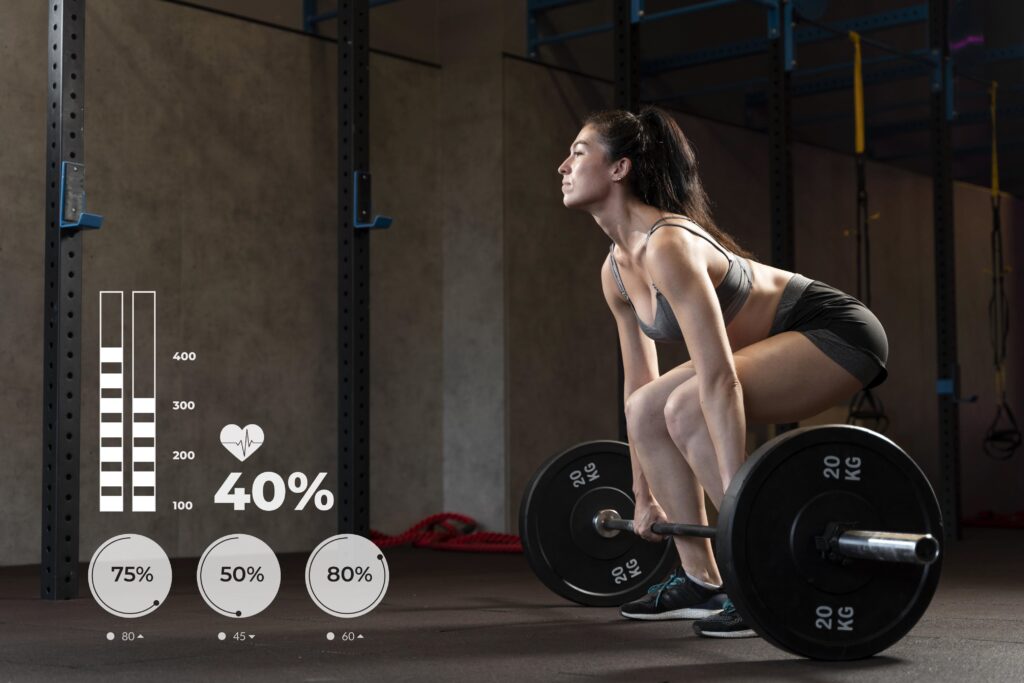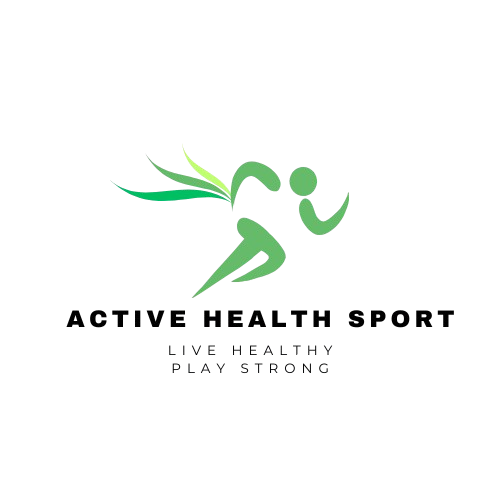Walking 10000 Steps Myth: Why It’s Not Enough for Optimal Health
For years, the idea of walking 10000 steps a day has been widely accepted as the gold standard for maintaining good health. Many fitness trackers and health apps use this number as a default goal, encouraging users to reach it daily. But is walking 10,000 steps really enough to improve cardiovascular health, build muscle, and enhance overall fitness?
The reality is that while walking is a fantastic low-impact exercise, it may not be the best way to achieve all your fitness goals. If your objective is to lose weight, build strength, or significantly improve endurance, you’ll need more than just step counting. In this blog, we’ll break down the fitness myths surrounding the 10000 steps rule and explore better strategies to enhance your daily exercise routine. So, let’s stay with us!
Where Did the 10,000 Steps Rule Come From?
The idea of walking 10,000 steps a day was not originally based on scientific research. It actually comes from a marketing campaign in Japan in the 1960s. A company selling pedometers created a device called the “Manpo-kei,” which translates to “10,000-step meter.” This catchy slogan became popular and, over time, was widely adopted as a general health recommendation.
While walking 10,000 steps does have health benefits, such as improving heart health and increasing daily movement, modern science suggests that it’s not a one-size-fits-all fitness solution.
The Origin of the 10,000 Steps Rule
The idea of walking 10,000 steps a day started in Japan in the 1960s. A Japanese company created a pedometer called the “Manpo-kei,” which means “10,000 steps meter.” The number was chosen as a marketing strategy rather than being based on actual scientific research.
Over time, this concept became widely accepted as a standard for daily exercise, despite a lack of evidence proving it is the best number for maintaining cardiovascular health.
Why 10,000 Steps May Not Be Enough
While walking is beneficial, it does not always meet all of the body’s fitness needs. Here’s why walking 10,000 steps a day may not be sufficient for optimal cardiovascular health and overall fitness:
1. Not Intense Enough for Cardiovascular Health
Walking at a moderate pace does improve cardiovascular health, but it may not raise the heart rate high enough to provide significant benefits. According to health experts, for daily exercise to improve heart health, it should include some level of moderate to vigorous intensity.
Better Alternative:
- Incorporate short bursts of high-intensity interval training (HIIT) into your routine.
- Aim for at least 150 minutes of moderate exercise or 75 minutes of vigorous exercise per week.
- Include activities such as jogging, cycling, swimming, or strength training.
2. Limited Impact on Muscle Strength and Endurance
Walking primarily works the lower body muscles, but it does not provide enough resistance to build significant strength or endurance. Cardiovascular health is important, but so is muscle health.
Better Alternative:
- Add bodyweight exercises like squats, lunges, and push-ups.
- Incorporate resistance training at least twice a week.
- Use weights or resistance bands for strength training.
3. Not Enough for Weight Loss and Fat Burning
Walking 10,000 steps a day burns calories, but it may not be enough for those looking to lose weight. The number of calories burned depends on factors like weight, speed, and intensity.
Better Alternative:
- Combine walking with interval training to increase calorie burn.
- Perform strength training exercises to build muscle and boost metabolism.
- Focus on a balanced diet along with daily exercise for effective weight loss.

4. Neglects Upper Body and Core Strength
Walking primarily works the legs and does not engage the upper body or core muscles significantly. For well-rounded daily exercise, the entire body should be engaged.
Better Alternative:
- Add planks, sit-ups, or yoga to target core muscles.
- Use resistance bands or light weights for upper body training.
- Perform full-body workouts to ensure balanced strength development.
How to Improve Your Daily Exercise Routine
If you want better cardiovascular health and overall fitness, consider upgrading your daily exercise routine with these strategies:
1. Add Strength Training
Many people focus on daily exercise by walking 10,000 steps a day, but this alone may not be enough to achieve overall fitness. Strength training is a crucial component of a well-rounded exercise routine, helping to improve muscle mass, metabolism, and strength.
Why Strength Training is Essential
- Boosts Metabolism: Muscle burns more calories than fat, even at rest. The more muscle you have, the more energy your body uses throughout the day.
- Enhances Bone Health: Lifting weights increases bone density, reducing the risk of osteoporosis and fractures.
- Improves Functional Strength: Stronger muscles make daily activities easier, from carrying groceries to climbing stairs.
- Supports Weight Loss: Strength training helps maintain lean muscle mass while losing fat, preventing muscle loss during a calorie deficit.
How to Incorporate Strength Training
Aim for at least two strength training sessions per week, focusing on different muscle groups. Some effective options include:
- Bodyweight Exercises: Push-ups, squats, lunges, and planks require no equipment and build strength effectively.
- Dumbbells or Kettlebells: Using weights for exercises like bicep curls, deadlifts, and shoulder presses adds resistance.
- Resistance Bands: These provide adjustable tension and are great for home workouts.
- Weight Machines: These machines are found in gyms and help target specific muscle groups safely.
Example Strength Training Routine (Full Body)
| Exercise | Reps & Sets | Muscle Targeted |
| Squats | 3 sets of 10-12 | Legs & Glutes |
| Push-ups | 3 sets of 10-12 | Chest & Arms |
| Deadlifts | 3 sets of 8-10 | Back & Legs |
| Plank | 3 sets of 30 sec | Core |
| Resistance Band Rows | 3 sets of 12-15 | Back & Arms |
2. Increase Workout Intensity
Walking 10,000 steps a day is beneficial, but it may not provide the intensity needed to significantly improve cardiovascular health, endurance, and calorie burning. Adding high-intensity workouts can enhance fitness and accelerate results.
How to Increase Workout Intensity
Instead of solely focusing on step count, incorporate exercises that challenge the body:
- Running or Cycling: These activities elevate the heart rate, improving endurance and lung capacity.
- Jump Rope or Stair Climbing: High-intensity, full-body workouts that burn more calories in a short time.
- Swimming or Rowing: Low-impact yet highly effective in engaging multiple muscle groups and improving cardiovascular fitness.
Benefits of Higher Intensity Workouts
- Burns More Calories in Less Time: A 30-minute high-intensity session can burn more calories than walking 10,000 steps.
- Improves Cardiovascular Health: Strengthens the heart and reduces the risk of heart disease.
- Builds Muscle and Endurance: Helps develop stamina and lean muscle mass.
Sample High-Intensity Interval Training (HIIT) Routine
| Exercise | Duration | Intensity |
| Jump Rope | 30 sec | High |
| Squat Jumps | 30 sec | High |
| Burpees | 30 sec | High |
| Rest | 30 sec | Low |
| Repeat for 3-5 rounds | – | – |
Even 20 minutes of HIIT can be more effective than an hour of steady-state walking.
Also Read: Why Jump Rope Is 2025’s Best Full-Body Workout
3. Include Flexibility and Mobility Training
Flexibility and mobility are often overlooked but play a crucial role in overall fitness. Incorporating stretching and mobility exercises helps prevent injuries, improve movement, and enhance posture.
Why Flexibility and Mobility Matter
- Reduces Risk of Injury: Tight muscles can lead to strains and poor movement patterns.
- Improves Posture: Sitting for long periods can cause imbalances; stretching helps counteract stiffness.
- Enhances Performance: Flexible muscles allow for better movement efficiency in workouts.
Types of Flexibility and Mobility Exercises
- Yoga: Improves flexibility, balance, and relaxation.
- Dynamic Stretching: Involves movement-based stretches like leg swings, arm circles, and hip openers before workouts.
- Static Stretching: Holding stretches for 15-30 seconds to lengthen muscles post-workout.
- Foam Rolling: Helps release muscle tightness and improve mobility.
Sample Flexibility Routine
| Stretch | Duration | Target Area |
| Standing Toe Touch | 30 sec | Hamstrings |
| Shoulder Stretch | 30 sec | Shoulders |
| Butterfly Stretch | 30 sec | Inner Thighs |
| Cobra Stretch | 30 sec | Lower Back & Abs |
| Cat-Cow Stretch | 30 sec | Spine & Core |
4. Monitor Heart Rate Instead of Steps
Many people focus on reaching 10,000 steps a day, but steps alone do not measure the intensity or effectiveness of daily exercise. Instead, monitoring heart rate can provide a more accurate way to assess cardiovascular health and ensure you are getting the most out of your workouts.
Why Heart Rate Matters More Than Steps
Walking 10,000 steps a day may not push your heart rate into the ideal zone for cardiovascular improvement. The body needs to reach a certain level of intensity to strengthen the heart and improve endurance. By focusing on heart rate zones, you can ensure that your workout is effective rather than just logging steps.
The ideal target heart rate zone for effective daily exercise is between 50-85% of your maximum heart rate. This range ensures that your workout is intense enough to improve cardiovascular health while still being safe.

How to Calculate Your Maximum Heart Rate
Your maximum heart rate (MHR) is the highest number of beats per minute (BPM) your heart can reach during intense physical activity. A simple formula to estimate your MHR is:
Maximum Heart Rate=220−Your Age\text{Maximum Heart Rate} = 220 – \text{Your Age}Maximum Heart Rate=220−Your Age
For example, if you are 40 years old, your estimated maximum heart rate would be:
220−40=180 BPM220 – 40 = 180 \text{ BPM}220−40=180 BPM
To ensure your workout is effective, aim to keep your heart rate within the following zones:
| Intensity Level | Percentage of Maximum Heart Rate | Heart Rate for a 40-Year-Old |
| Light Activity | 50-60% of MHR | 90-108 BPM |
| Moderate Intensity | 60-70% of MHR | 108-126 BPM |
| Aerobic Zone | 70-85% of MHR | 126-153 BPM |
| High Intensity | 85-100% of MHR | 153-180 BPM |
Benefits of Tracking Heart Rate Over Steps
- Ensures You Are Exercising at the Right Intensity
- Simply walking 10,000 steps a day may not push your body into the aerobic zone needed to improve cardiovascular health.
- Monitoring your heart rate allows you to adjust your effort and intensity to stay within the right zone for your fitness goals.
- Personalized Fitness Goals
- The 10,000 steps guideline is a one-size-fits-all number. However, heart rate tracking provides a more customized approach based on your body’s needs.
- Some people may need fewer than 10,000 steps with higher intensity, while others may benefit from more steps at a lower intensity.
- Maximizes Calorie Burn and Weight Loss
- Heart rate-based workouts can help optimize fat burning by ensuring you stay within the ideal fat-burning zone (60-70% of MHR).
- A person who walks 10,000 steps slowly may burn fewer calories than someone who does 30 minutes of interval training with the right heart rate.
- Improves Cardiovascular Health More Effectively
- To strengthen the heart, you need to engage in activities that raise your heart rate to at least 70% of your MHR for an extended period.
- Walking 10,000 steps a day at a slow pace may not be enough to challenge the heart and lungs.
- More Accurate Measure of Fitness Progress
- Step counts do not indicate improvements in endurance, stamina, or strength.
- Tracking your resting heart rate over time can show real improvements in cardiovascular health and fitness levels.
How to Track Your Heart Rate During Exercise
To ensure you are working out at the right intensity, consider using:
- Fitness Watches & Heart Rate Monitors – Smartwatches like Apple Watch, Fitbit, and Garmin can track heart rate in real time.
- Chest Strap Monitors – More accurate than wrist-based devices, chest straps provide precise heart rate readings.
- Manual Pulse Check – Place two fingers on your wrist or neck, count beats for 15 seconds, and multiply by four to get BPM.
Best Workouts to Keep Your Heart Rate in the Ideal Zone
Instead of focusing only on 10,000 steps a day, try these daily exercise routines to keep your heart rate at optimal levels:
- High-Intensity Interval Training (HIIT)
- Short bursts of intense exercise (like sprinting or jumping jacks) followed by rest periods.
- Helps improve heart health and burns more calories in less time.
- Brisk Walking or Jogging
- A slow walk may not be enough, but brisk walking or jogging can help maintain an ideal heart rate.
- Try alternating between fast and slow walking for better results.
- Cycling or Swimming
- These activities elevate heart rate while having a low impact on the joints.
- Great alternatives for those who cannot do high-impact exercises.
- Strength Training with Short Rest Periods
- Lifting weights or doing bodyweight exercises with minimal rest keeps the heart rate elevated.
- Works muscles while improving cardiovascular endurance.
Case Studies | Real Stories on Walking Beyond 10,000 Steps
At Active Health Sport, we’ve had the opportunity to connect with individuals who once believed that walking 10000 steps a day was the ultimate health goal—only to discover that their bodies needed more than just a step count to achieve optimal fitness. Here are three real-life experiences from our community that highlight the importance of movement beyond the numbers.
1. Isra Naqvi: From Step Goals to Strength Gains
Isra Naqvi, a 34-year-old graphic designer from Chicago, was dedicated to her 10,000-step goal, believing it was enough to maintain her fitness. However, despite her daily walks, she noticed she wasn’t losing weight or gaining muscle tone. After consulting a fitness expert, she realized that steps alone weren’t enough; she needed to incorporate strength training and higher-intensity movement.
By adding bodyweight exercises and resistance training three times a week, she saw significant improvements in her posture, energy levels, and overall strength. Isra now balances her steps with a more well-rounded fitness routine and feels healthier than ever.
2. John Luna: Beating Sedentary Lifestyle with More Movement
John Luna, a 45-year-old software engineer in Austin, had been tracking his steps religiously but struggled with back pain and stiffness. While he was consistently hitting 10,000 steps a day, most of his movement was in short bursts between long hours at his desk. After learning more about the importance of movement variety, John started incorporating stretching, mobility work, and midday walks into his routine.
Within a few weeks, he noticed a drastic reduction in his back pain and an improvement in his focus at work. He realized that walking 10,000 steps was beneficial but not enough if the rest of the day was spent sitting. Now, John prioritizes movement throughout the day, not just step goals.
3. Nico Andrea: A Wake-Up Call for Cardiovascular Health
Nico Andrea, a 52-year-old former athlete from Miami, thought he was staying active by walking his 10,000 steps daily. However, during a routine health checkup, his doctor warned him about rising cholesterol levels and reduced cardiovascular endurance. This was a wake-up call—while walking kept him moving, it wasn’t challenging his heart enough.
Nico decided to add interval training, short jogs, and cycling to his weekly routine. Within months, he noticed increased stamina, improved heart health, and even better recovery after workouts. Now, he emphasizes the importance of mixing intensity with steps to maintain overall cardiovascular fitness.
Key Takeaway: Steps Alone Aren’t Enough
Each of these individuals started with the belief that walking 10,000 steps a day was the ultimate fitness benchmark. However, their experiences prove that movement needs to be well-rounded, incorporating strength, flexibility, and cardiovascular challenges to truly support long-term health. If you’re relying solely on step count, it might be time to rethink your approach to fitness and explore other ways to stay active!
Closing Thoughts | Steps Alone Are Not Enough
Walking 10,000 steps a day is a great way to stay active, but it is not the only factor in maintaining cardiovascular health and fitness. To improve overall health, focus on a balanced daily exercise routine that includes strength training, flexibility exercises, and high-intensity workouts.
If your goal is weight loss, improved endurance, or building muscle, simply walking 10,000 steps a day may not be enough. Upgrade your routine by incorporating strength training, cardio, and mobility exercises for the best results. If you have any questions in your mind, feel free to comment below.
You might also like…
- Why Mobility Is the Real Strength You’re Missing in Fitness
 The Rise of Stiff Strength The modern fitness world has long celebrated heavy lifting, muscle growth, and endurance records, but it’s quietly ignored the foundation that makes all of those possible: mobility. In… Read more: Why Mobility Is the Real Strength You’re Missing in Fitness
The Rise of Stiff Strength The modern fitness world has long celebrated heavy lifting, muscle growth, and endurance records, but it’s quietly ignored the foundation that makes all of those possible: mobility. In… Read more: Why Mobility Is the Real Strength You’re Missing in Fitness - Why Functional Strength Outperforms Traditional Gym Workouts
 You can deadlift 300 pounds, but can you lift your child without back pain?You can squat twice your bodyweight, but can you climb stairs or carry groceries with ease? These questions reveal a… Read more: Why Functional Strength Outperforms Traditional Gym Workouts
You can deadlift 300 pounds, but can you lift your child without back pain?You can squat twice your bodyweight, but can you climb stairs or carry groceries with ease? These questions reveal a… Read more: Why Functional Strength Outperforms Traditional Gym Workouts - Why Your Fitness Plateau Is More About Movement Quality
 You’ve been consistent. You show up to your workouts, track your progress, and push hard. Yet somehow, your strength, endurance, or physique hasn’t improved in weeks or even months. Most people blame motivation… Read more: Why Your Fitness Plateau Is More About Movement Quality
You’ve been consistent. You show up to your workouts, track your progress, and push hard. Yet somehow, your strength, endurance, or physique hasn’t improved in weeks or even months. Most people blame motivation… Read more: Why Your Fitness Plateau Is More About Movement Quality

Kait Amazra is the founder and lead writer of Active Health Sport. With over 25 years of experience in health, fitness, and wellness education, Kait combines professional expertise with a passion for helping people live stronger, healthier, and more balanced lives.
As a licensed health and fitness professional, Kait has worked alongside industry experts to deliver evidence-based insights on physical activity, nutrition, recovery, and holistic well-being. Through Active Health Sport, Kait’s mission is to make trusted, practical, and science-backed health information accessible to everyone, from beginners building new habits to athletes seeking peak performance.

